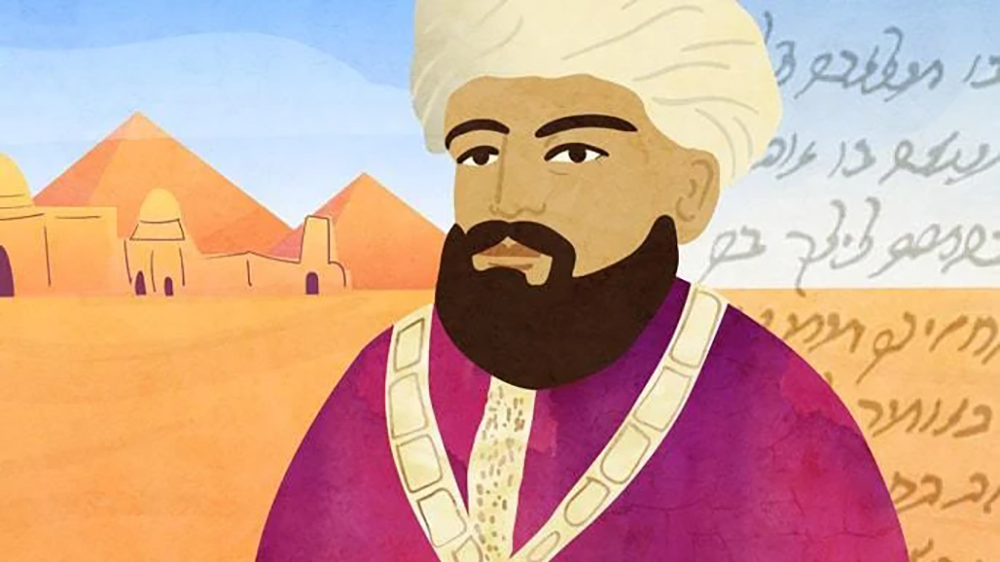By: Mordechai Rubin
- He Was Born Into a Prestigious Spanish Family
Maimonides was born circa 1135, in Cordoba, in the Andalusia region of Spain. His family traced their ancestry to the compiler of the Mishnah, Rabbi Yehudah HaNassi, and through him, to King David.1 Encouraged by his father—a judge on the Cordoba rabbinical court and a student of the famed Ri Migash—he pursued studies in Jewish law, philosophy, and medicine.
- Maimonides Means ‘Son of Maimon’
Maimonides, as he is known in English, is the Greek translation of “son of Maimon.” In Hebrew, he is referred to as ‘RaMBaM’ (רמב”ם), an acronym for Rabbi Moshe, son of Maimon.
- Little Is Known of His Mother
We know little about Maimonides’ mother, but it seems clear that she passed away when he was young—according to some accounts while giving birth to him. This would make his younger brother, David, a half sibling, although we do not know the identity of his stepmother either.
- Almohads Forced His Family to Flee
At the age of 13 (age 10, according to some), Maimonides’ family was forced to flee their hometown in the face of the Almohad invasion. This led to a 10-year period of wandering before the family finally settled in Fez, Morocco. Fez, too, had fallen to the Almohads (a group of fanatic Muslims), but it seems that they were able to survive incognito there for approximately five years.
- He Wrote His Commentary to the Mishnah on the Road
It was during this tumultuous time that he wrote the bulk of his first published work—the Commentary on the Mishnah.2 He began writing it at the age of 23 and completed it seven years later while living in Fustat (Cairo), Egypt. This work—written in Judeo-Arabic—was a monumental work, the first commentary on all six orders of the Mishnah, and can be described as a synopsis of the Babylonian Talmud. For each Mishnah, Maimonides provides an overview of the relevant Talmudic discussion, thus providing an indispensable resource for the novice and expert alike. This work served as a springboard for his magnum opus, Mishneh Torah.
- His Father’s Works Were Lost
Aside from exerting enormous influence on Maimonides’ works by serving as his primary teacher in his youth, Rabbi Maimon authored a number of his own works, including manuscripts on the festivals and prayer. These works were later lost over the course of time. The one complete essay we have from him is titled Igeret Hanechamah (“Letter of Consolation”), written amidst the various tragedies that befell the Jewish people at that time. There are conflicting reports as to exactly where he passed away, some believe he passed away in Jerusalem,3 while others report that he passed away shortly after the family settled in Fustat. He is buried near his son in Tiberias.
- He Published the First User-Friendly Compendium of Jewish Law
After settling in Cairo, Maimonides’ reputation as a brilliant scholar grew. It was there that he composed the Mishneh Torah, a complete elucidation of the Oral Law. Maimonides felt that the key tenets of the Oral Law were fading from memory, and therefore the time was ripe to set pen to paper and compose an authoritative work. He systematically explains the bottom line of halacha in a clear and concise manner, free of the tangled back-and-forth characteristic of the Talmud.
- He Was a Philosopher
The final work Maimonides published in his lifetime was The Guide for the Perplexed (Moreh Nevuchim)—a philosophical work that sought to reconcile traditional Judaism with the Aristotelian philosophy popular at the time.
- His Brother Perished at Sea
Shortly after the family settled in Egypt, Maimonides’ brother, David, embarked on a business venture with a significant amount of money belonging to the two brothers. Tragedy struck, and the ship on which he was traveling was lost at sea. His untimely passing devastated Maimonides to the point that he was bedridden for a number of months.
- He Was Appointed ‘Nagid’ (Chief Rabbi) of Cairo
At the age of 42, while still working on the Mishneh Torah, Maimonides was appointed Nagid of the Egyptian Jewish community. Nagid is a Hebrew term meaning prince or ruler, used as an honorific to refer to the leader of Sephardic Jewish communities. In this position, he was able to strengthen the community’s level of observance and subdue foreign influence. At the time, a considerable percentage of the Jews in Egypt followed the heretical Karaite sect. Maimonides was able to bring many back into the fold through his influential leadership.
- He Was a Court Doctor of the Sultan Saladin
After the death of his brother—who had been providing financial support for both families—Maimonides began practicing medicine, as he felt it would be improper to profit from his Torah knowledge. He became well known as a talented healer and was appointed one of Sultan Saladin’s doctors. In this capacity, he was able to exert significant influence over the government and even the Sultan himself.
- He Authored Works of Medicine
As a physician of some renown, he authored a number of medical treatises, including works on poisons and their antidotes, and proper hygiene practice. In his halachic works, too, he devotes considerable time to addressing health concerns. In the last years of his life, he devoted much of his time to treating patients, refusing to turn away anyone who sought his counsel.
- His Portrait is Based on an 18th-Century Rendering
We cannot be sure if the popular image we have of Maimonides actually resembles him at all. It seems that this image was first published in an 18th-century work titled “Thesaurus Antiquitatum Sacrarium.” It became popular shortly after its discovery and dissemination by Rabbi Yitzchak Shmuel Reggio, a rabbi in Gorizia, Italy, in the first half of the 19th century.
- His Works Were Controversial
Like many revolutionary thinkers, Maimonides’ works were initially met with suspicion. His critics felt that he had gone too far in transcribing and elucidating the Oral Law, and had done a disservice to his audience by not supplying the sources for his rulings. Most of the opposition was aimed at Mishneh Torah, the only work he composed in Hebrew. Later, when Maimonides’ Guide for the Perplexed was translated from Arabic, it too, met with great opposition. With time, however, not only were his works accepted, but Maimonides came to be rightfully recognized as one of the greatest Jewish scholars of all time.
- Autographed and Original Editions of Some of His Works Survive
It’s nothing short of miraculous that manuscripts written or authenticated by Maimonides himself have survived for over 800 years. Two handwritten manuscripts of his Commentary to the Mishnah exist today; they are held at the Bodleian Library in Oxford (Pococke 295) and at the National Library of Israel.4 Additionally, the Bodleian Library in Oxford contains a manuscript (known as Huntington 80) of the first two volumes of Mishneh Torah, Madda, and Ahava. At the end of the second book, Maimonides wrote: “Corrected against my own text, I, Moshe, son of Rabbi Maimon of blessed memory.”
- He Drew a Sketch of the Temple’s Menorah
One of the surviving manuscripts, (Pococke 295), assumed to be written in Maimonides’ own hand, contains a number of sketches, two of which are particularly well known. The first (on fol. 184v) is the famous depiction of the Temple Menorah with straight branches. This is a departure from the popular image of the menorah with curved branches. Although some dismiss this drawing as merely a rough sketch, Maimonides’ son, Abraham, believed that this was an accurate depiction.5 In more recent times, the Rebbe argued strongly that this depiction is the authentic menorah of the Temple.6 The second noteworthy sketch (on fol. 295r) is a map of the Temple, which shows the inner sanctuary as square, against the general convention that it was T shaped.
- A Partial Commentary to the Jerusalem Talmud was Discovered in the Cairo Geniza
After completing his Commentary on the Mishnah, Maimonides set about composing a work on the Jerusalem Talmud in the style of Rabbi Yitzchak Alfasi (the Rif). The work, titled Hilchot HaYerushalmi, hoped to select the halachot from the Jerusalem Talmud that deviated from the rulings in the Babylonian Talmud. Maimonides, however, did not carry this product to fruition and changed paths to focus on Mishneh Torah. In the Cairo Geniza, however, fragments of this unfinished work were discovered and published by Saul Lieberman. Many other fragments of Maimonides’ writings were also found in the Geniza—some in his own hand—including numerous responsa, versions of his Mishneh Torah, his Commentary to the Mishnah, and the Guide for the Perplexed.
- His Son, Abraham, Continued his Legacy
His son and student, Abraham, a noted scholar in his own right, defended Maimonides from his critics following his death. Additionally, like Maimonides, he served as Nagid to the community of Cairo and authored a commentary on Chumash, of which only Bereishit and Shemot survive.





